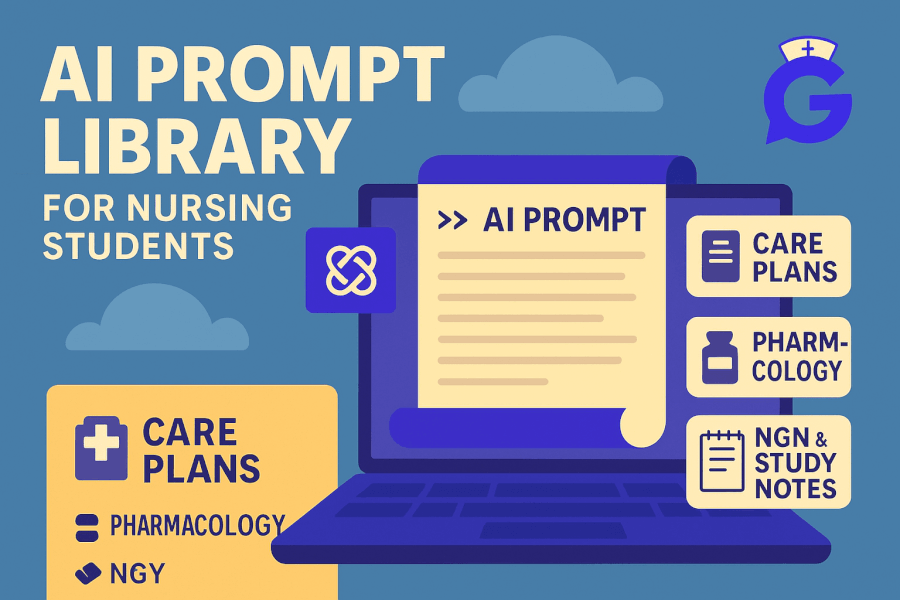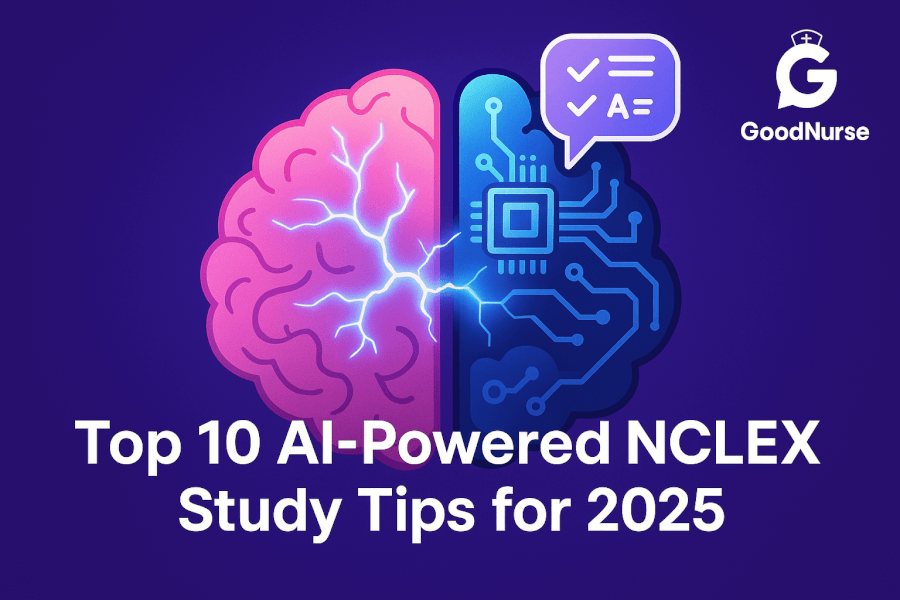If you’ve ever stared at a blank care plan or felt lost turning lecture slides into something usable, this page is for you. After 20 years at the bedside and 10 teaching and tutoring, I curated the exact AI prompts I give my students for care plans, pharmacology, NGN practice, and note-making. Use them as templates—then tweak for your course and patient scenario.
Faculty tip: The two biggest wins with AI prompts are clarity of task and context you supply. Tell the AI your course level, patient scenario, and the deliverable format (table, bullets, checklist). You’ll cut “redo” time in half.
Table of Contents
- How to Use These Prompts Safely
- Care Plan Prompts (NANDA, Goals, Interventions, Evaluation)
- Pharmacology Prompts (Mechanisms, Adverse Effects, Mnemonics)
- NGN Case & Item Prompts (Bow-Tie, Matrix/Grid, Rationale)
- Note-Making & Study Plan Prompts
- Clinical Writing & Professionalism Prompts
- Troubleshooting: Hallucinations, Citations, and Scope
- FAQs
- Further Reading
🎯 Free NCLEX quiz!
Test your knowledge—new quizzes added weekly!
How to Use These Prompts Safely
- No PHI. Never paste identifying patient information; de-identify and generalize.
- Cite textbooks/lectures. Ask the AI to format citations and then verify against your materials.
- Match level and rubric. Declare “ADN/BSN, first-term fundamentals” or “advanced med-surg” and paste the grading rubric bullets.
- Prefer checklists & tables. Structured outputs are faster to review and grade.
If you want the full context on AI best practices for nursing school, read the hub: AI in Nursing Education (2025): Complete Guide and our comparison page Best AI Apps for Nursing Students (2025).
Care Plan Prompts (NANDA, Goals, Interventions, Evaluation)
Use when: you have a patient scenario and need to build a clean, rubric-friendly plan.
Starter Prompt (copy/paste):
You are a nursing professor. Help me draft an RN-level care plan for an adult client with [primary problem] related to [etiology] as evidenced by [key assessment cues].
Constraints: 1) Follow NANDA format, 2) Include two SMART goals (time-bound), 3) Provide four nursing interventions with rationales and evidence sources, 4) Add evaluation criteria I can check in 24–48h. Output as a two-column table (Plan / Notes for Charting). Note level: [ADN/BSN term].
Example Fill-in:
- Primary problem: Impaired Gas Exchange related to pulmonary edema as evidenced by RR 32, SpO₂ 86% RA, crackles.
- Interventions align with our med-surg instability patterns—see NGN Med-Surg / Physiological Adaptation Case Studies (2025).
Add-on Prompt (prioritization):
Given this plan, list the two highest-priority actions that change physiology first, then two monitoring parameters that will improve within 10–30 minutes. Provide a one-line rationale for each pair.
Faculty tip: Make your Action → Parameter pairs explicit. That habit lifts NGN scores; tie it back to our NGN hub 25 Free Case Studies.
Pharmacology Prompts (Mechanisms, Adverse Effects, Mnemonics)
Use when: you’re building drug sheets or studying MOA/adverse effects/interactions.
Drug Sheet Prompt:
Create a concise pharmacology sheet for [drug/class] covering: mechanism, indications, high-yield adverse effects, contraindications, interactions, nursing considerations, and patient teaching. Include two NCLEX-style questions with rationales. Format as headings + bullets.
Compare/Contrast Prompt:
Compare ACE inhibitors vs ARBs for hypertension and heart failure: include mechanism, adverse effects (e.g., cough vs angioedema risk), nursing considerations, and teaching points in a four-column table.
Mnemonic-Builder Prompt:
Propose two safe, memorable mnemonics for [drug/class] emphasizing black-box warnings and must-not-miss adverse effects. Keep them academically appropriate.
For pharmacology patterns in NGN contexts, see NGN Pharmacology Case Studies (2025).
NGN Case & Item Prompts (Bow-Tie, Matrix/Grid, Rationale)
Use when: you want realistic NGN items that mirror exam structure.
Bow-Tie Generator Prompt:
Generate a bow-tie item about [clinical problem] with stem data (vitals, labs, meds, trends). Provide one correct problem, four actions (label the two best), and four parameters (label the two best). After the item, include scoring notes and a one-paragraph rationale.
Practice bow-tie structure with NGN Bow-Tie Items (2025).
Matrix/Grid Generator Prompt:
Create a matrix/grid item on [topic]. Rows: cues, actions, rationales. Columns: select relevant. Include partial-credit scoring guidance and a key. Keep 3–5 high-yield options per row.
Matrix strategies are outlined here: NGN Matrix/Grid Items (2025).
Rationale-Explainer Prompt:
Explain why the correct actions are priority for this case in three steps: 1) problem pathophysiology, 2) how the action changes physiology, 3) which parameter proves success in 10–30 minutes.
Note-Making & Study Plan Prompts
Lecture-to-Study-Guide Prompt:
Convert these lecture bullets into a two-page study guide with: key terms (one-line defs), must-know formulas, mini-tables for normal ranges, and three exam-style questions with rationales. Note level: [course/term]. Use headings, bullets, and tables.
Active Recall/Spaced Repetition Prompt:
Turn this study guide into 20 active-recall flashcards (question on top, answer below) and schedule them for spaced repetition over 4 weeks (days 1, 3, 7, 14, 28). Output as a simple checklist I can track.
Personalized Plan Prompt:
I’m [weeks] from NCLEX, weak in [topics], and can study [minutes/day]. Build a [4/6/8-week] plan with daily micro-sets (20–30 min) + weekly long block. Include NGN practice rotations and quiz links.
When you need a pacing template, use How Long Should I Study for the NCLEX? and category weights here NCLEX Categories & Subcategories.
Clinical Writing & Professionalism Prompts
SBAR Prompt:
Convert this situation into a concise SBAR for a handoff to the on-call provider. Include a one-line ask/recommendation at the end.
Therapeutic Communication Prompt:
Provide five therapeutic responses and two non-therapeutic examples to this client statement: “I feel like I’m failing as a parent.” Label each response and explain why.
Safety/Ethics Prompt:
List HIPAA-safe ways to summarize this case for AI assistance. Provide three examples of acceptable de-identification.
Troubleshooting: Hallucinations, Citations, and Scope
- Cross-check facts against your textbook/drug guide; ask the AI to cite page/section if possible.
- Re-prompt for level (ADN vs BSN) if explanations are too advanced or too basic.
- Bound the output: “Short bullets, two tables, one mini-case.”
Faculty tip: When AI gives two plausible actions, pick the one that changes physiology first (oxygenation/perfusion) and that you can measure in 10–30 minutes—this is the scoring sweet spot on NGN.
FAQs
Can I paste patient details into an AI?
No—de-identify thoroughly. Use generic descriptions and never include names, dates, or identifiers.
Will professors know I used AI?
They’ll notice good structure and clear thinking. That’s fine—just cite sources and keep the work authentically yours.
How do I get better at prompting?
State the task, the level, the format, and the rubric. Then iterate with “shorter,” “add a table,” or “justify each step.”







